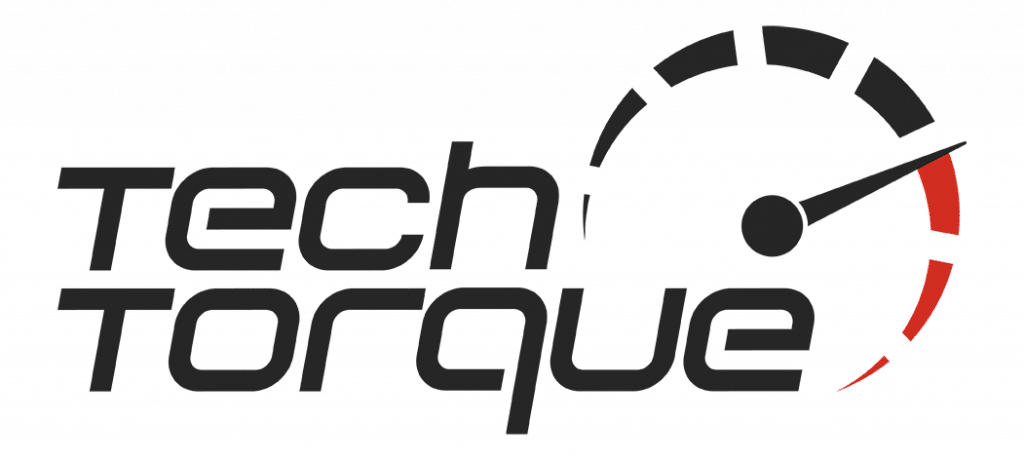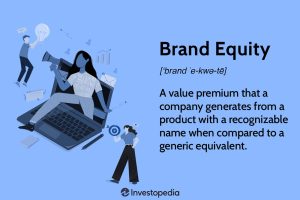Find out how you compare. Are big competitors outspending you on Digital Marketing? Probably. Do you need to match them? Probably not but, whatever you spend, be sure that growth – not just activity – is the goal.
In this post, we look at:
- How much global technology players spend
- In comparison to Aussie tech companies spend
- Their budget spending habits
- Ways you can spend far less, but still compete and win.
So, How much do the big guys spend?
Australian technology vendors often compete with global giants who have stratospheric sales and marketing budgets. Here’s what some spend:
According to an infographic from Vital, Marketo spends a whopping 66% (US$98.8m) of revenue on sales and marketing, Salesforce 53% (US$2.2m), Oracle 20% (US$7.6m), Microsoft 15% ($8.1m), and Apple 7%(US$12m). They’re pretty big figures from mighty big players, but they combine sales with marketing, so this is not an accurate picture.
According to a Deloitte CMO survey, Software and Biotech companies now spend 15% of their companies’ total budgets (not revenue) on marketing. For Communications & Media companies, it’s 13%.
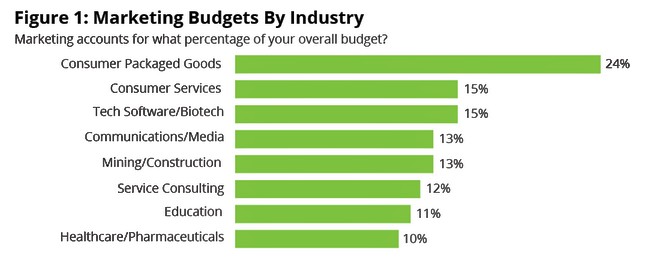
How do they spend their budgets?
The last few years have seen seismic shifts in marketing, from social media to mobile marketing and automation. Marketing is mostly digital and heavily reliant on automation. As a result, martech spending is now consuming 30% of marketing budgets according to Gartner, in large organisations with more than $500 million in revenue.
That percentage is likely to grow much bigger as marketers deploy Artificial Intelligence (AI), which its champions claim will revolutionize marketing as we know it. AI will deliver more accurate data on customer behaviours and buying / browsing habits, enabling marketers to target content and emails with more precision than before. AI can even create emails, or choose subject lines and images, and fine-tune messages based on previous interactions with targets. It can even predict when the target is likely to unsubscribe. The only obstacle to rapid adoption of AI technologies is their complexity.
Meanwhile, content is still king. The 2019 CMI B2B Content Marketing Survey tells us where most marketers are spending their budget:
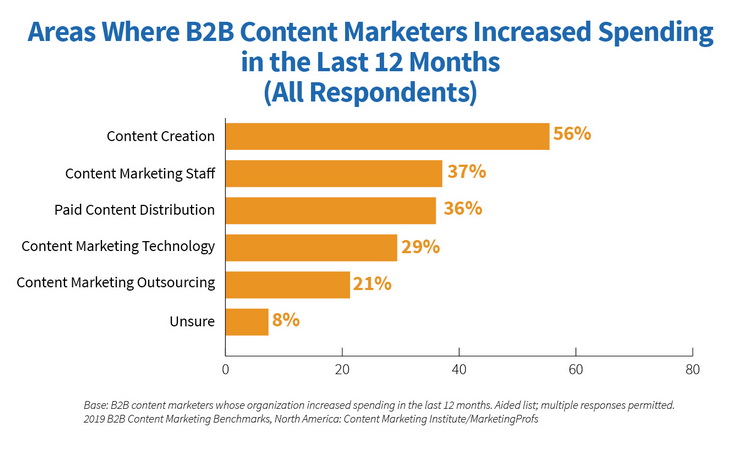
Areas where marketers should spend more money
The CMI 2019 B2B Survey found that fewer than half of content marketers talk to customers as part of their audience research – just 42%. The majority use feedback from sales and website analytics to research their audience, and two thirds use keyword research. This is the flipside of relying too much on marketing automation. After all, your customers are in a great position to tell you what information they want to see more of, and what they can do without.
They can also give you insights into the key issues in their industries, and tell you what your competitors are saying and doing, so it makes perfect sense to have regular conversations with your customers. Doing this gives you a competitive advantage, and an opportunity to strengthen your relationships with your customers, and it doesn’t cost anything.
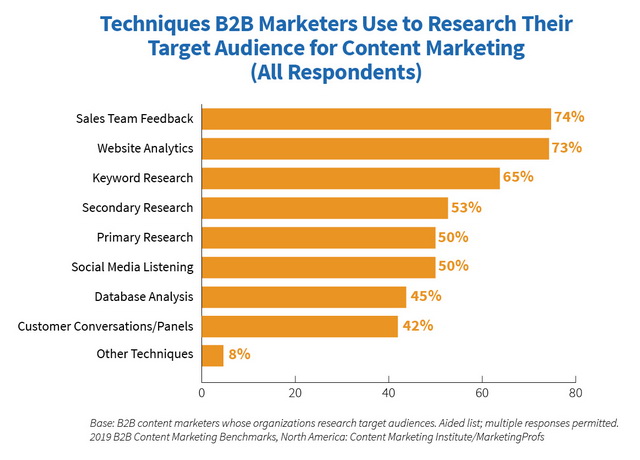
How much should you spend on Digital Marketing?
This is the question most frequently asked by CEOs, followed by ‘and how much is enough?’. The CFO will of course say ‘less than we spend now’.
The answer depends on a few more questions, and the most important of them is: what do you want to achieve? If you want to grow your revenue by 50% a year, you’ll have to spend a lot more on marketing than if your goal is 10%. Your existing revenue baseline is key here too. How achievable your goals are, and how much you’ll need to spend, also depend on how established you are in your target market(s), how accepted your technology is there, and how much competition you face.
So, if you’re a start-up, you’ll have to spend more on marketing and profile-raising than established players. If your technology is disruptive or entirely new, you’ll have to put effort and money into educating the market first. You’ll have to spend on differentiation if you’re one of many competing vendors. And so you can attract new investors, you’ll need to spend on marketing the broader benefits of your technology and your management expertise.
Digital Marketing costs less if you’re the Thought Leader
If your technology is the stand-out performer and you are (or have the potential to become) the thought leader in target markets, you could enjoy enviable growth with a reduced marketing spend.
This is why small high tech companies should aspire to being Thought Leaders. It gives smart companies an undeniable edge, and it’s fits better with small size: true thought leaders are usually small and agile, never large and cumbersome. It’s a critical element in achieving growth in a market awash with large, well-heeled competitors.

What’s your Strategy?
Spending money on isolated tactics without a clear marketing strategy can burn cash faster than a bush fire. Spending too little or spending on piecemeal, uncoordinated activities will also burn money, just less of it. Whatever you spend on marketing, it needs to be based on a workable B2b Product Launch strategy, even if it’s just 3 bullet points on a napkin. You need to focus on:
- Where your technology could win – and you could become the Thought Leader
- What your target buyers need from you – to make a choice in your favour
- How to reproduce and automate these activities – so they generate a high return at a low cost.
- How your in-house team have a track record with Digital Marketing in It Companies.
What do Aussie hi-techs spend on Digital Marketing?
Accurate figures are not available, but previous surveys found that two thirds of Australian companies with a turnover of $5 to $50 million spent less than $500,000 on marketing. Yet, how much less and by what companies by size or industry, we can’t tell. Our own experience in the technology sector – where most clients fit into the $5-50 million turnover range – suggests that it’s closer to 5% than 10% in Australia.
Aussie technology companies spend about half of what the big global players do, in relative terms. The upside for small players is that the big guys have to splash cash everywhere: events, analyst reports, collateral, social, search, email marketing and more – in every market – because they have to be seen and heard everywhere. You don’t. You only have to focus your marketing on:The markets you can win – where your technology is superior Becoming the Thought Leader – because you know the patch better than anyone else (especially the big guys) A strategy that will help you do both.
What are they spending big on?
There are few surprises here: as you’d expect:
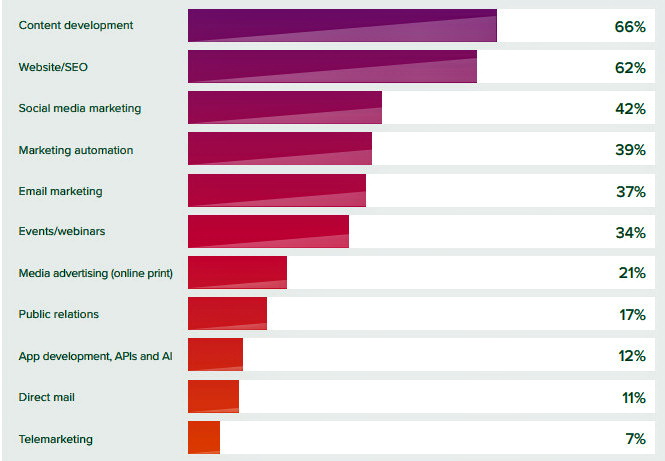
Source: 2018 Green-Hat-ADMA-B2B-Marketing-Research-Report
The key to lower spend and higher ROI
You don’t have to take on every market or every competitor. You just need to focus on those you can win or beat, which will dramatically trim your marketing spend, while boosting your marketing ROI. This is the sort of thinking that will make the CEO really happy, not to mention the CFO.
For small technology companies, it’s essential to maintain a clear marketing focus on segments with the best chance of success. The next rule is to focus on activities that will grow your business. After all, tech marketing is supposed to be an investment, not an expense.
As we said above, content is still king. Long form content is valued by both business people and search engines, as long as it’s relevant, well researched and well written. However, video content is really popular now that most of us are using smartphones with big data allowances. The downside is that video content is expensive to produce, and can get boring very quickly when explaining technical issues. Short 2-minute videos are the most effective, and don’t cost big dollars. When they’re crisp, clear and snappy, they’re perfect for getting the attention of your target audience and bringing them to your website.
On the other hand, the ROI on social media is still fuzzy.
Warnings like these are not uncommon: ‘If you want to improve your marketing ROI, stop spending on social media.’ (eConsultancy); ‘Marketers struggle to prove social media ROI (PR Daily). ‘Social media spending falls to levels last seen in August 2017,’ reports Deloitte’s 2019 CMO Survey, reversing the strong positive growth recorded in the two previous surveys. One reason may be that despite massive financial investments, social media is rated as contributing only moderate value to company performance.’
Clearly a lot of companies are still struggling to make Social Media Marketing work for them. Some of our customers have struggled as well, and have asked us take care of it for them. Rather then other B2B marketing companies we’ve found LinkedIn by far the most effective social media channel in the B2B world
Learn about our approach to marketing in the technology sector or contact us about a gaining higher ROI on your marketing spend.
Original text written by Tracey James and Updated by Matthew Whyatt
